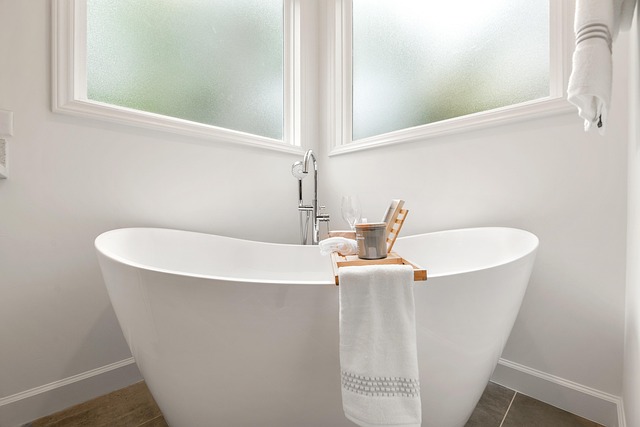A well-designed low-maintenance bathroom for rental properties balances durability and aesthetics. Using waterproof finishes, non-porous tiles, efficient plumbing, and durable materials like porcelain, it can withstand high foot traffic, moisture, and inconsistent cleaning. This approach reduces maintenance, minimizes damage, and keeps the space clean and appealing over time, focusing on easy-to-maintain surfaces, storage solutions, and strategic material choices for a superior low-maintenance bathroom design.
In today’s dynamic rental market, creating a low-maintenance bathroom design that withstands tenant use is crucial. This article guides property managers and landlords through essential strategies to achieve just that. We explore understanding tenant behavior, selecting durable materials, implementing effective waterproofing, and integrating efficient storage solutions. By adopting these practices, you can enhance the longevity of your bathroom investments while ensuring a seamless experience for tenants. Embrace a balance of functionality and low-maintenance aesthetics with these expert tips tailored for optimal bathroom design.
Understanding Tenant Use Patterns and Their Impact on Bathrooms
Tenants, especially in rental properties, often bring unique habits and patterns into a space. In the case of bathrooms, understanding these behaviors is key to creating a low-maintenance design that can withstand daily use. High foot traffic and frequent exposure to moisture make bathrooms susceptible to wear and tear, so materials need to be durable and resistant to common issues like mold, mildew, and water damage.
Tenant use patterns can vary widely, from quick morning routines to longer evening baths. This variability requires a bathroom design that accommodates various activities without compromising aesthetics or functionality. Additionally, tenants may not always follow proper cleaning practices, emphasizing the need for easy-to-maintain surfaces and fixtures. A thoughtful selection of low-maintenance materials, such as waterproof finishes, non-porous tiles, and efficient plumbing, can ensure a bathroom that remains inviting and fresh over time.
Benefits of Low-Maintenance Materials in High-Traffic Areas
In high-traffic areas like bathrooms, opting for low-maintenance materials can significantly enhance the space’s longevity and aesthetic appeal. These materials are designed to withstand frequent use, making them ideal for commercial or multi-tenant properties where regular cleaning and repair can be challenging. For example, choosing durable vinyl flooring over traditional tile reduces the need for intricate sealing and grout maintenance, saving time and resources in the long run.
Low-maintenance bathroom design also extends to wall finishes and fixtures. Scratch-resistant surfaces and easy-to-clean coatings on doors, mirrors, and countertops minimize visible wear and tear, ensuring these features remain prominent and attractive. Such materials not only simplify cleaning routines but also reduce the risk of damage, contributing to a more welcoming and well-maintained environment for tenants.
Choosing Durable Surfaces for Longevity and Ease of Cleaning
When designing a low-maintenance bathroom, selecting durable surfaces is key for both longevity and ease of cleaning. Materials like porcelain and ceramic tiles are popular choices due to their resistance to scratches, stains, and water damage. These hard surfaces are ideal for high-traffic areas as they can withstand frequent use without showing signs of wear and tear. Moreover, their non-porous nature makes them easy to maintain; simply wiping them down with a damp cloth or sponge will keep them looking fresh.
Compared to softer materials like vinyl or carpet, durable tiles offer a more hygienic environment. They don’t trap moisture or harbour bacteria, reducing the need for extensive cleaning. This is particularly beneficial in bathrooms where proper ventilation and regular sanitization are crucial. Opting for these robust surfaces contributes to a long-lasting low-maintenance bathroom design that requires minimal upkeep while ensuring a clean and healthy space.
Waterproofing Strategies: Protecting Your Investments from Moisture Damage
In the realm of low-maintenance bathroom design, waterproofing strategies are paramount to protect investments from moisture damage. A robust waterproofing system involves multiple layers of protection, starting with high-quality tiles and surfaces that resist water penetration. Grout, a crucial component, should be chosen for its waterproof properties to prevent seepage between tiles. Additionally, using water-resistant or waterproof membranes beneath tiles adds an extra barrier against moisture intrusion.
Beyond the initial installation, regular maintenance is key. Sealing grout lines annually with a suitable sealant prevents water from finding weak spots. For added protection, consider incorporating waterproof coatings on walls and floors, ensuring that all joints and crevices are sealed tightly. These measures collectively contribute to a durable, low-maintenance bathroom design that minimizes the risk of water damage over time, fostering a pristine environment for tenants.
Incorporating Efficient Storage Solutions to Reduce Clutter and Wear
In any rented space, efficient storage solutions are key to maintaining a low-maintenance bathroom design that withstands regular use from tenants. By strategically incorporating storage features, landlords and property managers can significantly reduce clutter, one of the primary causes of wear and tear. Customized storage units, such as built-in shelves or cabinets, allow for organized placement of towels, toiletries, and other essentials, ensuring items don’t pile up on counters or floors where they can lead to damage.
Moreover, efficient storage encourages tenants to maintain a tidy space, which is beneficial for both the aesthetics and longevity of the bathroom. With designated areas for everything, there’s less chance of items being left out or improperly stored, minimizing the risk of water damage from spilled liquids or mold growth due to poor ventilation. This proactive approach not only conserves the bathroom’s initial condition but also fosters a sense of responsibility among tenants who appreciate having a functional and well-organized living space.
When designing a bathroom for tenant use, prioritizing durability and low-maintenance materials is key. By understanding tenant behavior and implementing strategic choices, such as waterproof surfaces, efficient storage, and robust materials, you can create a functional space that withstands the test of time and minimizes upkeep. Adopting these practices not only ensures a more enjoyable living environment for tenants but also protects your investment in the long run, making it an ideal approach for any low-maintenance bathroom design.
